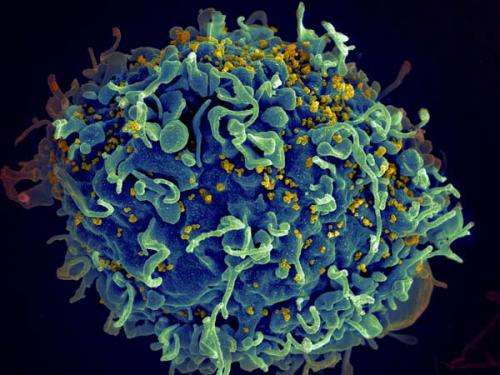HIV, the AIDS virus (yellow), infecting a human immune cell. Credit: Seth Pincus, Elizabeth Fischer and Austin Athman, National Institute of Allergy and Infectious Diseases, National Institutes of Health.
There are almost 40 million people throughout the world living with HIV-1/AIDs. While current antiretroviral therapies are able to reduce the amount of virus in the blood, HIV remains present in a latent state within T cells. Reactivation of latent HIV-1 in combination with potent antiviral drugs has potential as a strategy to eradicate the virus from infected individuals.
A new study in the Journal of Clinical Investigation reports on the development of a multifaceted approach for identifying drug combinations that reverse HIV-1 latency. Robert Siliciano and colleagues collected T cells from HIV-infected individuals and assayed these cells for the presence of HIV-1 within cells and the production and section of intact virus, which is indicative of reactivation.
A comparison of various 2-drug combinations revealed that several were able to reverse latency. Importantly, several combinations were able to reactivate HIV-1 without the development of an inflammatory response.
The authors also developed a model to correlate changes in HIV-1 RNA in a patient's blood with the amount of virus secreted from isolated T cells. The techniques developed in this study have potential to inform future clinical trials for strategies to eliminate HIV-1 reservoirs in infected individuals.
More information: Identifying effective HIV-1 latency-reversing drug combinations through ex vivo analysis J Clin Invest. DOI: 10.1172/JCI80142
Journal information: Journal of Clinical Investigation
Provided by Journal of Clinical Investigation




















